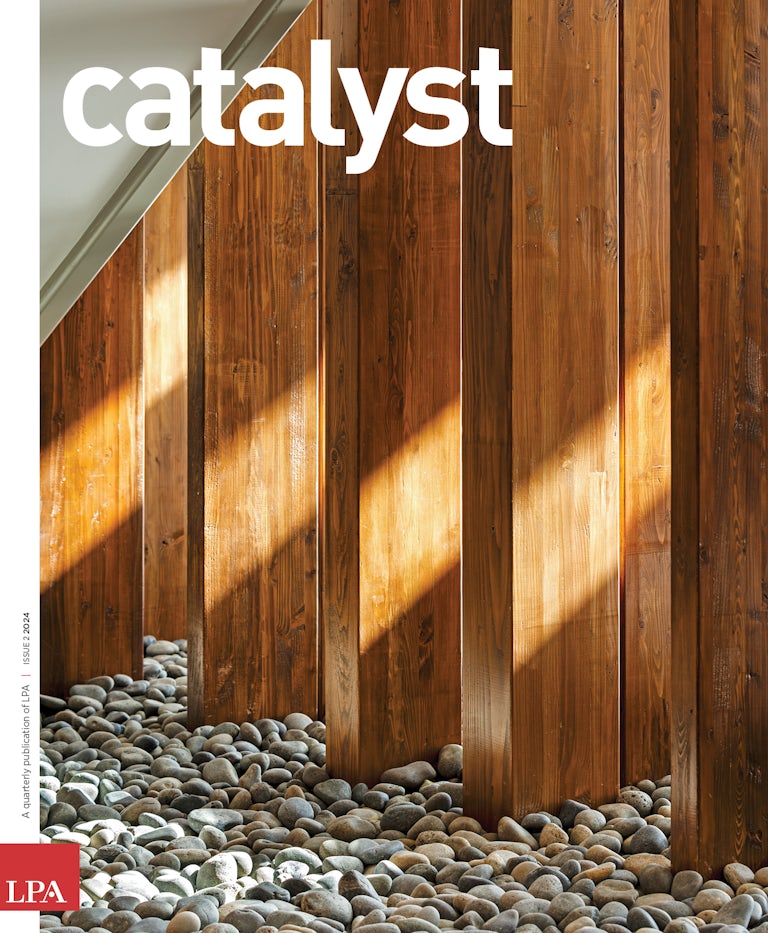Designers can do more to expand delight, joy, serenity and connections to nature, Gail Brager argues in a new book. Her work focuses on linking academia to real-world solutions.
As associate director of UC Berkeley’s Center for the Built Environment (CBE), Gail Brager, PhD, is leading efforts to develop research on energy performance and indoor environments to create “transformational change in the building industry.”
The center provides timely, unbiased information on building technologies, design and operation strategies. (Note: LPA is a longtime industry member of the CBE.)
Brager is the coauthor, with Mark DeKay, of Experiential Design Schemas, which presents a new theoretical and practical framework for designing architectural experiences.
In an interview, Brager, who is also a professor of architecture at the University of California, Berkeley, discusses the keys to improving performance, a new mindset for design and facing the next generation of challenges.
What’s the next big step for the design and construction industry?
I don’t think there is a single big step. In general, the next steps are about connecting design and performance, whether it’s energy or experience or wellness. One way is to change the scale that we use to think about how to create better environments for people, such as people-based rather than space-based conditioning strategies.
A lot of the CBE’s research centers on personal control and air movement and integrated systems to condition people, not just volumes of space.
Your book talks about the mindset of enhancing the positive, not just reducing the negative.
So many of our building standards that designers, architects and engineers need to adhere to are often framed in terms of “How do we reduce the negative? How do we reduce complaints by creating environments that no one notices?” Instead, what if we did actually notice the environment, but in positive ways?
What do you mean by positive?
I’ve been focusing on positive in terms of sensory experience — the thermal, visual, acoustic and olfactory environments. When you change your language, it changes the way you think about things. Instead of just making it less bad, we can focus on making it better. The book is about bridging evidence from building and health sciences with architectural design strategies to connect people to more variable environments that connect us to nature, and make us feel good!
There’s always the question, are these enhancements going to add cost?
I think that’s a great question. Most of the time, probably not. I think for the most part it simply requires centering people when thinking about your design. Perhaps it leads to subtle differences in where you put people in the building or how you’re orienting workspaces in relationship to windows, or what you do as an entry sequence. These are not fancy ideas. These are about starting with an experiential perspective.
Another example is that we tend to design for average people. Instead, what if one begins by asking “How do you provide choice and agency to serve neurodivergent populations?” How does that thinking end up serving everyone, because we all may want different experiences and at different times? That doesn’t necessarily have anything to do with designs that are more expensive. It’s being more intentional and putting people’s experiences to the forefront when you’re trying to make those decisions.
What role does integrated design play in your research?
Principles of integrated design typically mean getting everybody to the table early and often. I think there are parallels of that in research as well, and this is an important part of the CBE consortium. It’s helpful to have players from different disciplines and backgrounds, with their unique ways of thinking and language, talking to each other from the early conception of research objectives, to developing methods, to interpreting results and applications.
How does the discussion change as we emphasize embodied carbon as well as operational carbon emissions?
This is a relatively new and growing area of focus for my colleagues at CBE, led by Matt Roberts. Reducing carbon emissions is a complex challenge, and it requires that all members of the building design team — the owner, the developer, the contractor, the building management team, the tenants — come together.
We’re grappling with four main challenges. One is establishing a consistent base level of knowledge across the industry, so these different players can actually engage in conversations. Number two, we really can’t just be thinking about embodied carbon or any other dimension of sustainability as a tack-on element after all the other design decisions are made. Carbon strategies have to be an integrated part of the decision making, and it has to come early. I think the third thing is collective responsibility for the challenge. Too often we think we’re just going to hand things over to somebody else, and then we have somebody else to blame. We need collective and supportive engagement from all parties. Then the last challenge is that reducing carbon does not have a one-size-fits-all solution. It’s really complicated, and what works for one project might not work for another.
What makes you hopeful these days?
What makes me hopeful about the building industry — what gets me up in the morning — is young people. I have been so privileged for the last 40 years to work with this demographic of people, mostly in their 20s, some early 30s. I personally find inspiration from them on almost a daily basis. They are inherently interdisciplinary in their interests. They want to break down silos. They are driven by making the world a better place. In spite of the challenges and uncertainty out there, I find that they’re passionate, they’re hopeful, they’re advocates. They’re the ones who challenge us to rise up and think differently. They are definitely the ones who keep me hopeful for the future.



